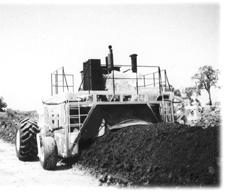by Diana Barnum
 < <
Most yard waste composting facilities in the U.S. use windrow
technology, as shown here.
Composted grass may not be a pretty shade, but the money coming from
yard waste composting sure is. This is one area where the grass is
definitely greener on the other side…of the compost facility, that
is.
“The composting and organic recycling industry is doing well
despite the economy today,” according to Dr. Stuart Buckner, executive
director of the U.S. Composting Council. “One area of significant growth
is yard trimmings composting projects. The number of facilities that
handles this nationwide has grown from about 650 in 1988 to over 3,800
today.”
Why the increase? Two reasons: content and bans. A shift from
mainly leaf composting to mixed yard waste that includes grass clippings
and brush caused an increased need for facilities to handle the material.
But the main reason is local and regional bans on yard waste disposal in
landfills created a sudden need for facilities. At the time of Dr.
Buckner’s research, presented in a report entitled, “The Current Status Of
Organics Recycling And Composting In The United States,” 22 states had
these bans in effect.
Yard waste generates the most waste,
approximately 28 million tons last year, of which 45% is recovered with
composting. However, Buckner notes that yard trimmings are down. He
reported 35 million tons in 1990 compared to 30 million in 1999.

A handful of compost enriched soil.
“The number of facilities may have plateaued, but growth is expected
to continue at a slower rate,” said Buckner.
He noted that components
of growth and non-growth are due to an increase in demand for composted
projects and an increasing demand for sources. Successful reduction
campaigns like “grasscycling” or leaving the clippings on the lawn is also
a factor.
A negative factor in the industry is odor control. But
Buckner found that successful facilities are site-specific in design,
process management, material handling and odor control throughout their
entire operations.
Equipment and Technology Most yard waste composting
facilities in the U.S. use windrow technology. Some use static piles.
Generic pieces of equipment that are required at most facilities include
shredding machinery, front- and back-end machinery, aerating or turning
machines and bagging equipment. Exact models of equipment depend upon the
type of waste (some facilities handle biosolids and other materials),
mixture, how it is delivered, quantity delivered, regulatory requirements
such as speed and proximity to neighbors and the site’s size.
“The U.S.
Composting Council can help determine equipment needs,” advised
Buckner.
He did note two new models of equipment that have enhanced the
industry lately; logger shredders and varied screens. Logger shredder
manufacturers are expanding the shredder’s ability with a variety of sizes
and shapes. And screen manufacturers are designing a variety of sizes and
speeds. These new models help meet the different facility sizes out there,
as some handle leaves and grass, some also include brush and others add in
stumps.
Some of these new screens were chosen by Kevin Tritz, president
of the U.S. Composting Council and multi-facility operator for Specialized
Environmental Technologies, Inc. of Bloomington, MN. Tritz is a
subcontractor who manages 11 compost sites for NRG Energy Center in
Minneapolis with 72 employees. His group is known as the Resource Recovery
Division.
On one NRG site that handles yard waste, organics are also
taken in. A standard picking line checks the content of materials that
arrive with a horizontal Mueller unit. They use a 7400 Peterson Pacific
Unit horizontal shredder for grinding yard waste and organics go into
biodegradable bags.
Tritz participates in a pilot program that sends
the balance of materials to the energy plant to make fuel for electricity.
He began hauling 10,000 tons per year or 40 tons per day in 1998 for the
program. Now the amount is 150 tons per day. Transportation is a problem,
though.
“We’re going through pilots with some haulers to collect
organics,” said Tritz. “Receiving material and transporting materials
economically is a large problem to overcome.”
Biodegradable bags with
co-mingled waste are hopefully in the future.
“It’s the evolution of
recycling,” Tritz explained.
The U.S. Composting Council listed more
than half a dozen markets and applications for compost. The demand of more
than 1 billion cubic yards per year goes to:
• Retail and homeowners
for landscape and garden needs
• Sports turf
• Nurseries for
growing plants
• Landscaper Companies
• Agriculture for crops and
soil
• Silviculture for seedlings and mulch
• Topsoil blenders to
amend soil
• Landfills for cover
• Roadsides for erosion control
and growing solutions.
An estimated 500,000 cubic yards of compost used
in 2000 by the states’ Departments of Transportation alone, and a
projection of more than 18 million cubic yards needed per year, equals a
lot of revenue. Grass could very well be greener on the other side of the
compost facility.
For more information and composting solutions,
contact Dr. Stuart Buckner at the U.S. Composting Council, 200 Parkway
Drive South, Suite 310, Hauppauge, NY 11788. Call: (631) 864-2567; or fax
inquiries to: (631) 864-3796. Kevin Tritz can be reached at Specialized
Environmental Technologies, Inc., 8585 W. 78th Street, Suite 240,
Bloomington, MN 55438. Call: (952) 946-6999; or fax inquiries to: (952)
946-7975. |